Consciousness in The Cell (41-50)
41. The Hormones that Refute Darwinism
 | |
| 1. right adrenal gland | 3. right kidney |
Without your even realizing it, thousands of commands are being passed through your body every second, to make your life as easy and as practical as possible.
When you get excited or frightened, for instance, your stimulated nervous system, with great speed and without getting lost, activates the glands above your kidneys. On receiving the message, these adrenal glands secrete a hormone called adrenalin which, entering the bloodstream, calls your whole body to attention. It inhibits the activity of the stomach and intestines and halts the process of digestion. In this way, a significant portion of blood, no longer involved in digestion is now freed to supply the muscles. At the same time, your heartbeat and blood pressure increase. The bronchioles in the lungs expand, speeding up the absorption of oxygen and the supply of oxygen to the blood. The blood level of glucose increases too, leading to an increase in energy to the muscles. Finally, the pupils dilate and your eyes' sensitivity to light increases.
The result of all of these factors coming together is that you are equipped to perform in any situation, whether to run away, to defend yourself, or to attack.
Nerve cells are formed from lifeless, unconscious atoms. But these structures comprehend situations where the body is in need and immediately send messages to relevant regions of the body. The parts that receive the message are also made up of lifeless atoms, but despite this, they immediately "get the message" and act to produce the necessary hormone. Then this hormone, knowing full well the purpose for which it was made, travels throughout the body to activate the relevant organs.
To think that such a consciously planned, organized and purposeful system could have come about through coincidence is to turn a blind eye to all logic and common sense. Darwinists, by claiming that this whole system came about as a result of coincidence, have placed themselves in a very comical position where even children would mock at their assertions.
In fact, world-renowned British writer and philosopher Malcolm Muggeridge also stated this:
I myself am convinced that the theory of evolution, especially the extent to which it's been applied, will be one of the great jokes in the history books in the future. Posterity will marvel that so very flimsy and dubious an hypothesis could be accepted with the incredible credulity that it has. (Malcolm Muggeridge, The End of Christendom, Grand Rapids: Eerdmans, 1980, p. 43)
The clear and evident truth is that God, the Superior Creator, has created this flawless system.
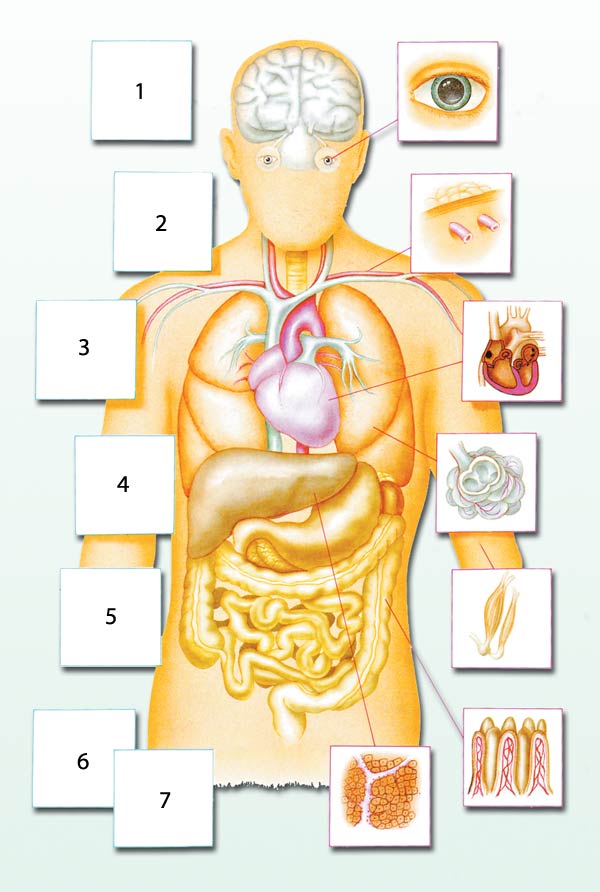 | |
| 1. Pupils dilate | 5. Muscles expand. |
| When you get excited or frightened, the adrenaline hormone, secreted by the adrenal glands above the kidneys, sends the body into immediate high alert. The diagram summarizes this hormone's effects on the body. | |
42. The Lungs Have Their Own Emergency Defense Unit
Some cells in the lungs actually spray a natural biocide over bacteria and other microbes. This way, microbes and bacteria that enter through the respiratory tract and manage to reach the lungs alive are killed there.
Obviously, it's not possible for lung cells to recognize harmful substances, much less know to produce whatever's needed to neutralize them. Cells are devoid of abilities such as thinking, cognition, decision-making, or planning. These are all products of God, the One Who created it all in harmony and balance, and regulation with the heavens and the Earth. By making just one cell perform acts with such consciousness that dumbfounds human beings, God displays signs of His infinite knowledge and wisdom.
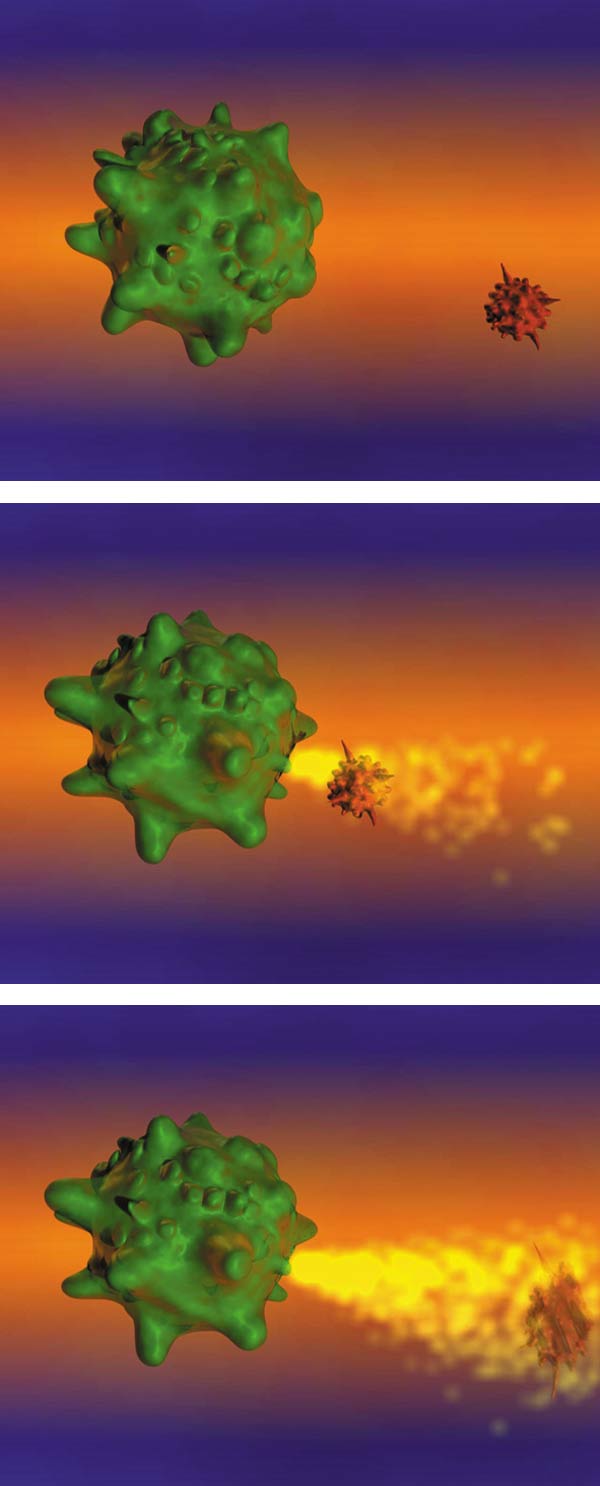 |
| Cells in the lungs have their own defense system. Immediately identifying microbes that enter the body through the respiratory tract, they secrete a substance that neutralizes these microbes. That a tiny cell invisible to the naked eye can distinguish between microbes and other substances is a great miracle, because if it makes the wrong decision, it could neutralize a substance the body actually needs. |
43. Were It not for Enzymes, It Would Take You 40,000 Years to Read This!
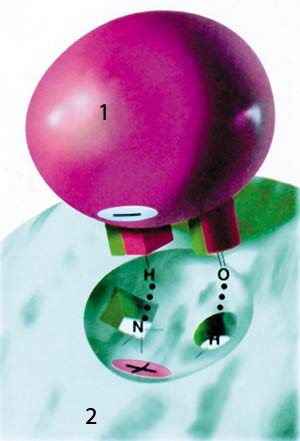 |
| 1. Molecule 2.Enzyme The diagram at left shows an enzyme about to bind to a molecule |
Enzymes are protein molecules that make life possible, promoting the necessary chemical reactions for life by boosting them up to just the right speed.
One enzyme can speed up a reaction by a factor of 1010—that is, ten billion times faster. If this speeding-up didn't occur, then the five-seconds it takes to read this sentence might take 1,500 years! During this time, so many other unwanted chemical reactions could also take place that life wouldn't just be slowed down; it would become impossible.
Another important feature of enzymes is their selectivity. While they speed up the desired reactions, they don't speed any undesired ones. But how do these enzymes know which reactions need to be hastened and which do not? To do this, they must be aware of all of the reactions and functions taking place in the body, and what is needed when.
Moreover, each enzyme can speed only chemical reactions in which certain molecules take place. An enzyme can bind only onto the specific site on a particular molecule. For this reason, the enzyme must fit into the special site on the molecule as a key fits a lock. Each enzyme has to recognize its particular molecule, and the specific site where it must attach itself.
Why have these enzymes, made from unconscious atoms of carbon, hydrogen and oxygen and which have no brain, eyes, mind or consciousness, taken up the responsibility of speeding reactions in the body? And how can they determine the right molecule to bind to and the particular sites on which to bind?
How have coincidences and unconscious atoms decided that enzymes were needed for life to continue?
Evolution theory, which accepts coincidence and unthinking atoms as deities, has no answer to these questions. The truth is that these enzymes have been designed and created for life by a superior Power and Creator—that is by God.
44. Antibodies can Fight Microbes They have Never Encountered Before
 |
| And Allah makes the Signs plain to you: for Allah is full of knowledge and wisdom. (Qur'an, 24:18) |
Every day, thousands of microbes infiltrate the body, and the human immune system immediately tries to neutralize them. However, some microbes and foreign agents that can't be avoided enter the bloodstream and pose a serious danger. These foreign agents are called antigens. But the immune system produces substances called antibodies, that act against these antigens, and try to destroy them and prevent them from multiplying.
Antibodies' most important feature is their ability to recognize—and then prepare themselves to destroy—the hundreds of thousands of different microbes found in nature. Most interestingly, some antibodies can even recognize synthetic antigens, prepared in the laboratory and then injected into a test subject.
How can one cell recognize hundreds of thousands of different foreign ones? Moreover, how does it attain the ability to recognize a substance that has been synthesized artificially? Even if we accept that antibodies can somehow recognize antigens in the body, it is still astounding that they can also recognize an antigen they have never come across before. In addition, since the antibodies can identify the foreign agent that has entered the body, they then produce the most effective weapons to use against it. Coincidence cannot explain how a mechanism inside the body can possess such astonishing information about the outside world. This fact leaves the evolutionists in a bind. Having failed to explain with their theories antibodies' ability to identify all types of foreign agents entering the body, evolutionists try to gloss over the topic with illogical, scientifically unacceptable explanations.
One example of the explanations of how an antibody can recognize synthetic antigens can be seen in the words of Turkish evolutionist Professor Ali Demirsoy:
... A cell that has developed the ability to synthesize an antibody against a chemical agent which was made synthetically in the 20th century must be a clairvoyant. (Professor Ali Demirsoy, Kalitim ve Evrim (Inheritance and Evolution), Meteksan Publications, Ankara 1995, p. 420)
As Professor Demirsoy suggests, evolutionists admit the perfection in living things, but try to explain it away with quite imaginative methods. They try to hypnotize people with magical statements like, "This is a miracle of evolution," or "This cell must be clairvoyant." However there is an extraordinary situation here. The word clairvoyant is used for people who claim to have precognitive abilities. The fact that a cell has knowledge about things that exist far distant from it is quite extraordinary. A cell composed of lifeless atoms cannot be expected to possess strong intuitive powers or knowledge about the future by coincidence, of its own accord. To make such a claim is to exceed the limits of reason and logic. This much is apparent: These antibodies were given their talents by God, the One Who has knowledge of everything down to its smallest detail.
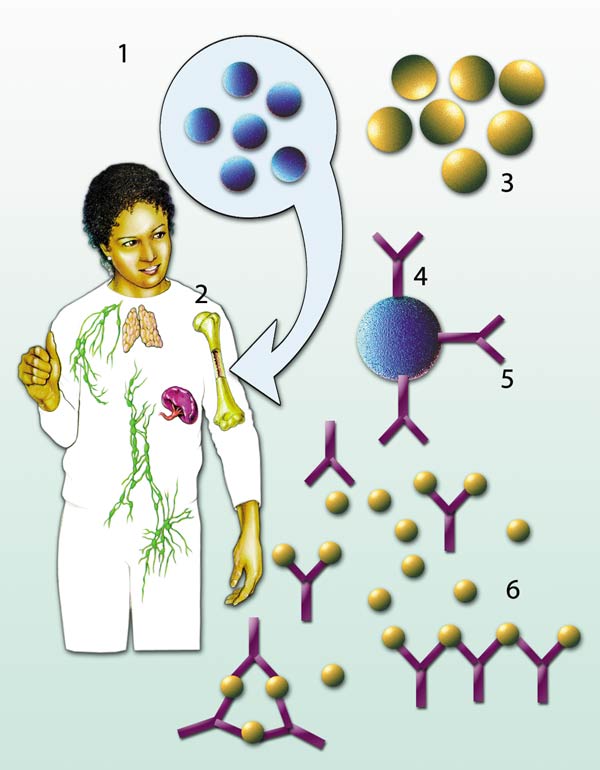 | ||
| 1. B cells | 3. External antigens | 5. Antibodies |
45. Cells of the Immune System Have Been Created with Large Memories
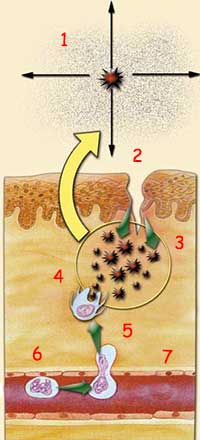 | |
| 1. Bacterial waste products spread out. 2. wound 3. Bacterial waste products arising from microbes 4. Macrophage engulfs the bacteria. 5. Macrophage advances to the site of the wound. 6. Blood vessel 7. Macrophage arrives, via the blood vessel, at the site of the wound. |
When cells receive news ofmicrobial attack, they immediately warn the immune system.
Whenever you get an infection—for example, when microbes invade an open wound—cells of the immune system are immediately activated. These defensive cells, known as macrophages, identify the area of infection in the least amount of time and initiate a response against microbe attack and then hasten to this area. Macrophages are sensitive to a number of changes. For example, they identify bacterial waste in a given area, along with the presence of destructive substances produced by infected tissue, as well as factors involved in blood clotting. If macrophages couldn't identify any changes in infected tissue, they wouldn't be able to respond to the innumerable number of dangers the body faces every day.
But here is something interesting: Most macrophages are coming face-to-face with such an attack for the first time. If so, how did these microscopic living cells learn what constitutes danger? Have they had training in this matter?
Obviously, it's impossible for these microscopic macrophages to have been educated in any way. All this information has been in their memory since the macrophages first came into being. A power has given them this memory and inspired them with the knowledge of how to protect the body from outside enemies. The One Who has acquainted them with the impact of attacks from outside is the Lord of the worlds, Who created them together with this knowledge—that is, God.
 |
| When we hurt ourselves, we are certain that the wound will soon heal. But how few of us even think of who heals that wound? |
46. In What You See—but Don't Think About—Lie Hidden Infinite Knowledge and Miracles
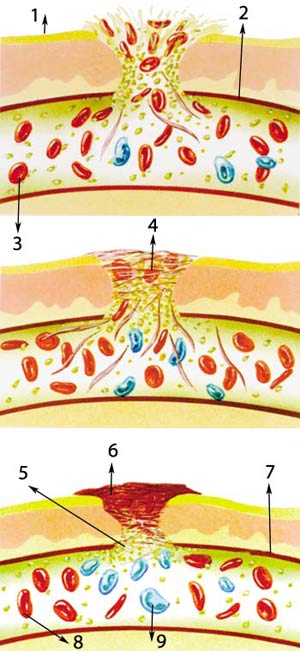 | |
| 1. Skin | 6. Scab formation |
If you cut your finger, in a short time the blood will clot and stop the bleeding. But how does this clotting take place in such a short time? And what takes place in your body?
The event of blood clotting is similar to what occurs when an ambulance and police cars come hurrying to the site of a highway accident.
Whenever bleeding begins in any part of the body, first aid arrives from blood platelets called thrombocytes, which are dispersed throughout the bloodstream. No matter where bleeding takes place, there are sure to be thrombocytes in the body patrolling nearby.
A protein called von Willebrand factor works like a traffic policeman calling for help, indicating the location of the accident and cutting in front of the thrombocytes so that they remain in the area.
As if communicating by wireless, the first thrombocyte that arrives on the scene calls for help by secreting a special substance that calls other thrombocytes to the site.
Meanwhile, twenty enzymes found in the body come together to form a protein called thrombin over the open wound. Thrombin is produced only at the site of the wound, like a first aid team manufacturing the medicine needed by the patient on the spot. Moreover, this needs to be produced in just the right amounts; and the thrombin production must start at just the right time and stop at the right time. The orders for starting and ending production are encoded among the enzymes that make up this protein.
Once enough thrombin has been produced, tiny fibers of fibrinogen are formed. They have the very important role of forming a net over the blood, thereby trapping and accumulating the thrombocytes that begin to arrive. Once enough fibers have accumulated, blood stops oozing out from the wound. Once the wound has healed completely, the blood clot is then broken down by similar methods.
These enzymes and proteins are structures that come together by the different ordering of lifeless, unconscious, blind atoms. Each of these is in an organized state from the time the wound occurs, and takes up a particular duty to stop the bleeding as soon as possible. Together, they synthesize the necessary proteins and then "send for help." As if understanding the reality of the situation, the other proteins immediately arrive at the wound, each one performing its duty without fail.
Let it not be forgotten that the enzymes that carry out the "organization," "synthesis," "calling for help," and "understanding" have come about as a result of atoms coming together. This display of apparent consciousness by a molecule of unconscious atoms is certainly a great miracle.
It is certainly impossible for such a system to have arisen in living things as a result of coincidence. Each detail of this system is a product of planning and calculation, evidence of God's infinite knowledge, power, and wisdom. The claim that this system came about as a result of coincidence is an example of the faulty logic that Darwinists display.
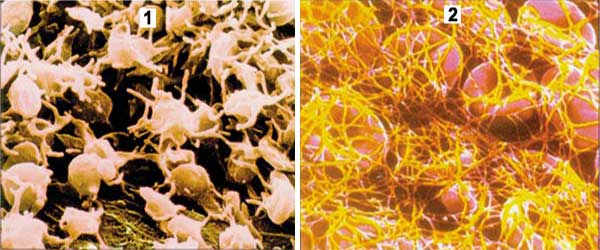 | |
| 1. Clotting cells | 2. Blood clotting |
| When bleeding occurs anywhere in the body, proteins entrusted with stopping the bleeding immediately arrive at the site. | |
47. The Details of Even the Tiniest Molecule are Enough to Destroy the Theory of Evolution
The protein thrombin allows the blood to clot by converting fibrinogen to fibrin. Even though this protein is always circulating through the blood, however, it doesn't always lead to the clotting of blood, thereby preventing blood flow. If there is bleeding in one blood vessel only, it "understands" that clotting is needed there and sets about clotting the blood. If thrombin always led to clotting, all of the blood in the vessels would clot as a result of the thrombin present, and the body could not survive with its circulation totally blocked. So how does thrombin attain the ability to cause clotting only in the place where it's needed?
Thrombin is usually present in blood plasma in an inactive form called prothrombin. Being inactive, it cannot perform the duty of clotting and in this way we are protected from the fatal consequences of uncontrolled clotting.
But what activates prothrombin and converts it to the clotting factor thrombin when bleeding occurs?
A protein in the blood called Stuart factor has the effect of converting prothrombin to thrombin. However Stuart factor is itself also present in an inactive form, and needs to be activated.
At this point we are faced with a chicken-and-egg scenario. Still another protein called accelerin is needed before Stuart factor can become active and turn prothrombin into thrombin—thereby stopping any bleeding in the organism. But what's truly remarkable is that accelerin, too, is present in an inactive form of its own, called proaccelerin. And what activates proaccelerin?
Thrombin!
But if you recall, thrombin comes after proaccelerin in this chain reaction. This sequence of events, in which thrombin plays a role in the production of accelerin, is like a grandchild being born before its own grandmother. But because the effect of Stuart factor on prothrombin is very slow, small amount of thrombin is always present in the blood. As a result, this small amount of thrombin first activates accelerin and then, each of the proteins needed for clotting go into action, like cascading dominoes.
We've explained here only the very superficial facts about the clotting process. To claim that this whole system—consisting of so many parts working together interdependently, with each part performing its duty without neglect—is all the result of coincidences is illogical and irrational.
Evolutionists do claim that living things, together with all their systems including blood clotting, evolved step by step. But in order for clotting to take place, all the proteins and enzymes involved depend on one another. Remove one component, and all the rest are rendered useless—and would actually lead to the death of the organism. As a result, any organism with an incomplete clotting system wouldn't have time for the other parts of the system to be completed and would die long before it could reproduce. Consequently, this one example invalidates the claim that organisms evolved from intermediary species. But we could multiply these examples exhaustively, because living bodies continue their existence on behalf of hundreds of such interdependent systems.
The Creator of all of these systems is God.
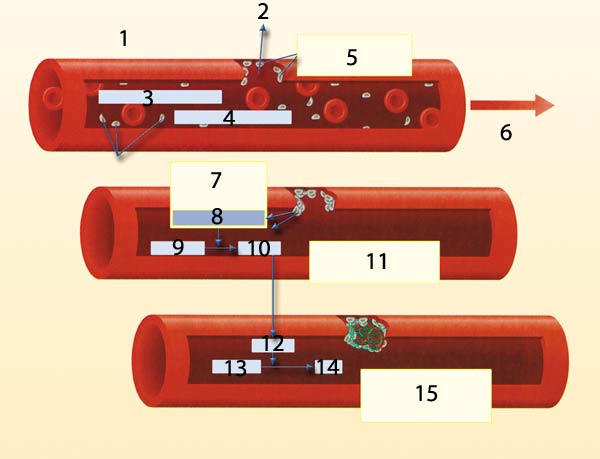 | |
| 1. Wound | 10. Thrombin |
| At the site of a wound, many interdependent proteins go into action to allow blood clotting. These proteins, activated when the body receives a wound, in turn activate each of the other proteins required for clotting. | |
48. Your Life Depends on Something as Flimsy as a Cotton Thread
With the absence of just one enzyme, the human species could go extinct. Only one example should suffice to dramatize this.
Nerve cells, called neurons, envelop our bodies, forming an interconnected web. A constant flow of information takes place along this web of neurons. Electric signals traveling along the length of each neuron transfer innumerable commands and warnings between the brain and other organs.
But neurons do not form one long cable extending from one part of the body to another. They are placed end to end, but do not even contact each other directly. There are gaps between them.
So how does the electricity flow from one nerve cell to the next?
It does so thanks to a very complicated chemical system that comes into play. Between nerve cells is a special fluid containing very specialized chemical enzymes, with the extraordinary ability to transport electrons. When an electric signal reaches the end of the nerve, its electrons are deposited onto these enzymes. The enzymes, carrying their electrons, then move through the fluid and transfer the electrons to the next nerve, thus passing along the electric signal. This process takes place within the smallest fraction of a second, and under no circumstances is the flow of electricity ever cut.
Again, even if all of the parts of the human body were complete, the lack of this one enzyme would be enough to prevent the organism from carrying out any functions at all. The same would arise if any single one of the other thousands of enzymes were lacking. No organism has the luxury of waiting millions of years for blind coincidence to complete its ability to survive, as is claimed by the theory of evolution.
The one apparent truth here is that all living things, humans included, were created with their perfect and faultless structures all at once—that is, they were perfectly created by God.
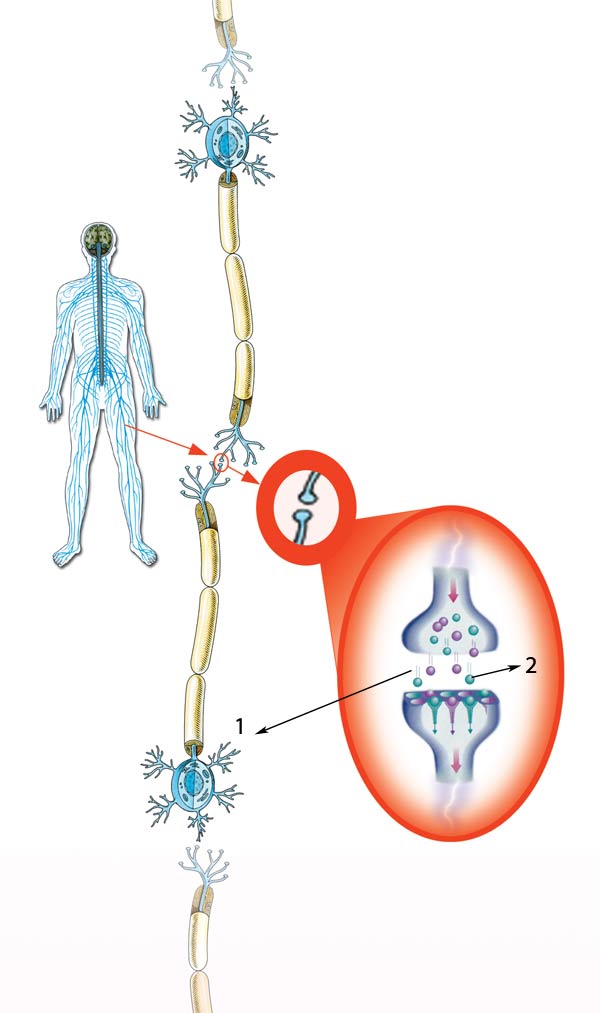 |
| 1.The gap between two nerve cells, and the enzymes entrusted with carrying electrical signal from one cell to the other 2.The enzyme that transmits the electrical signals to the next nerve cell |
49. The World's Most Complex Network Lies in Our Brain
With the aid of the perfect structures in the human brain, we have the ability to perform a number of tasks at the same time. For example, you can drive a car while at the same time working with the dials on the cassette player and being in control of the steering wheel. Even though you are doing a number of things at once, you do not crash into the car on the road in front. While controlling the accelerator with your feet, still you can understand exactly what is being reported on the news broadcast on the radio. You can continue a conversation with a passenger where you left off. In short, you can perform a good number of different things simultaneously thanks to your brain's extraordinary capacity.
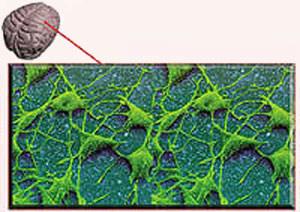 |
Facilitating this cooperation is the interdependence of the brain's nerve cells, which number about 10 billion. Some 100 trillion connections facilitate communication among these cells. In Evolution: A Theory in Crisis, Michael Denton explains just how huge a number 100 trillion really is:
Numbers in the order of 1015 are of course completely beyond comprehension. Imagine an area about half the size of the USA (one million square miles) covered in a forest of trees containing ten thousand trees per square mile. If each tree contained one hundred thousand leaves the total number of leaves in the forest would be 1015, equivalent to the number of connections in the human brain.
The extraordinary character of our brain does not end with the sheer number of its neural connections, because every one of the 100 trillion is in the exact place where it's needed. If even one of these connections were in the wrong spot, there would be a fault in this network, with very grave consequences. But this does not happen. Apart from a few exceptional diseases, people continue their existence as a result of trillions of miraculous processes that come naturally to them.
Darwinists claim that these 100 trillion connections arose as a result of coincidences. According to them, some 10 billion of the 100 trillion cells in the human body somehow decided, on their own, to become nerve cells and consequently adopted the required shape and changed their features—all at once! Not content with this miraculous display, they connected to each other perfectly, using 100 trillion connections, without even one of them being incorrect. This Darwinist claim is akin to saying that New York City's electricity network came about coincidentally after a storm one night and allowed current to reach every single house, bar none.
It's clear and evident that a superior power formed and controls this perfect system. This Power is the Creator of us all—God.
50. Everything You Learn is an Example of the Splendor of God's Creation
The nerve cells in your body are like a net, over which innumerable commands and warnings between the brain and the organs are communicated. This net is not continuous, however. As we just mentioned, there are gaps between these neurons, and when a message reaches these gaps, electron-carrying enzymes, or neurotransmitters, transfer the message to the next neuron.
Once these neurotransmitters have deposited their charge onto the end of the next nerve fiber, they are free. But if they were to accumulate there, they would block the path of the next lot of transmitters coming from behind. In such a situation, the electrical signal will not be passed onto the next neuron, and the flow will be interrupted. But such a problem never occurs, because a special enzyme called acetylcholinesterase destroys chemicals that build up at the end of the nerve fiber. In other words, it sweeps the area clean. In this way, the path is constantly made clear for the transmitters arriving from behind, eliminating the slightest glitch or interruption in the transmission of impulses.
And so, out of the thousands of enzymes in our bodies, if even this one, acetylcholinesterase, were lacking, it would mean the breakdown of the electric signaling throughout the body; we would not be able to survive.
At this point, each of us should ask ourselves: Who has formed these faultless systems in the bodies of all living things, in which the smallest detail has not been overlooked? Who has programmed molecules that do not possess consciousness, knowledge or will, to display the most intelligent, appropriate behaviors?
None of this intelligence, knowledge and perfect artwork can be coincidental! Evolutionists are necessarily quiet on their answer to these questions. Because the One Who created each enzyme—and Who inspired each with its duty, and Who created this life perfectly from non-existence—is God.
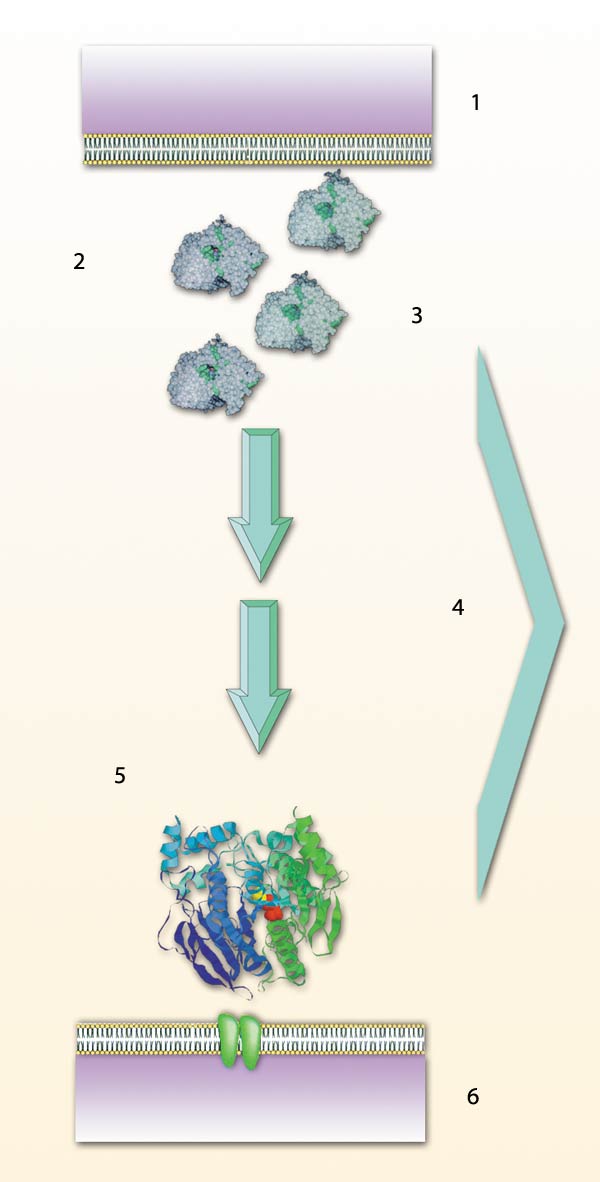 |
| 1. End of a nerve fiber 2. The enzyme called acetylcholinesterase is found at the sites in the body where it is most needed. It sweeps away acetylcholine enzymes that accumulate between two nerve cells after they've transmitted an impulse between them. This way, it makes room for new transmitter enzymes. 3. Acetylcholine enzymes transmitting an impulse 5. Acetylcholinesterase enzyme, waiting to sweep up the neurotransmitter enzymes after they finish their duty |
They said "Glory be to You!
We have no knowledge except what You have taught us.
You are the All-Knowing, the All-Wise."
(Qur'an, 2: 32)
